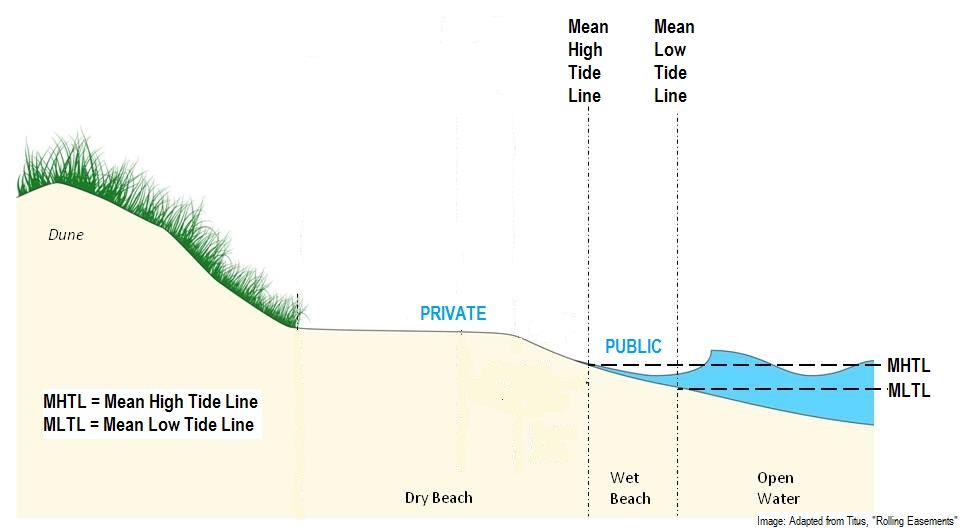Common Law Tools to Promote Beach Access
Public Trust Doctrine
The public has a right of access along the beaches and shorelines of Florida situated below the “mean high tide line” (see diagram below). Article X, Section 11 of the Florida Constitution clarifies that the state holds the land seaward of the mean high-tide line (MHTL) in trust for the public. This is commonly known as the “Public Trust Doctrine.” Traditionally, the public trust doctrine contemplated fishing, commerce, and navigation as a basis for public access, but more recently has been expanded to embrace recreational uses such as bathing and swimming. Some have argued to expand state land “held in the public trust” to cover just the wet sand to cover the dry sand as well.

Expressed / Implied Dedications
In Florida, a land dedication is viewed as a license (or permission from the land owner to use their property) that can be revoked at-will.
Prescriptive Easements
The public can establish an easement, or right to use the property of another for a specific purpose, by prescription. Prescription is an adverse use of property, or use without permission, for a set period of time. In Florida, prescriptive easements are difficult to prove because courts require a strict finding of “adversity.” This is hard to establish because courts often view public access across private property as something a private landowner has acquiesced to, or given implied permission.
Eminent Domain
This involves a government taking property for a legitimate state purpose, in this case access to the beach. Although this may be viewed as a legitimate state purpose, it is far too expensive for Florida to acquire all oceanfront lands so all the sandy beaches belong to the state.
“Customary Use” Doctrine
Pioneered by Oregon, some states (like Texas and Hawaii) have followed suit by recognizing that people have customarily gathered to live, hunt, fish, navigate, trade, cook, etc. along the shore, therefore the public has acquired the right by “ancient” custom. In Florida there is a burden of proof issue, requiring a proponent of the doctrine to establish the particular parcel of beach in contention has been customarily used by the public, and that use has been uninterrupted for a long duration. This can be difficult to establish, but it has been done.
The FL Supreme Court has recognized, in a limited way, the “custom doctrine” (as applied to a specific area of a particular beach) in City of Daytona Beach v. Tona-Rama Inc., 294 So. 2d 73 (Fla. 1974). However, in Reynolds v. County of Volusia, 659 So. 2d 1186 (Fla. 5th DCA 1995), the Fifth District Court of Appeal clarified the geographic scope of the Supreme Court’s opinion in Tona-Rama. The court stated that the doctrine of custom requires “courts to ascertain in each case the degree of customary and ancient use the beach has been subjected to and, in addition, to balance whether the proposed use of the land by the fee owners will interfere with such use enjoyed by the public in the past.” Therefore, unlike Oregon, the doctrine of custom according to Reynolds is applied on a tract-by-tract basis in Florida.
Other tools for Beaches
This document from the U.S. Environmental Protection Agency provides more than a dozen approaches for implementing rolling easements. Rolling easements are a legal tool that allow wetlands and beaches to migrate inland as people remove buildings, roads, and other structures from land as it becomes submerged, effectively preserving coastal access to for the public.
Maine Property Owner’s Guide to Managing Flooding, Erosion & Other Coastal Hazards
Guide to help property owners evaluate threats and decide what they should do to protect their property. Designed for Maine, but much of the information also applies to Florida property owners.
Beach Access Case Studies & Publications
Ponte Vedra Case Study
Destin Case Study
Sarasota Case Study
Singer Island Case Study
Florida Beach Users’ Perceptions of Beach Ownership, Erosion Management and Sea-Level Rise
